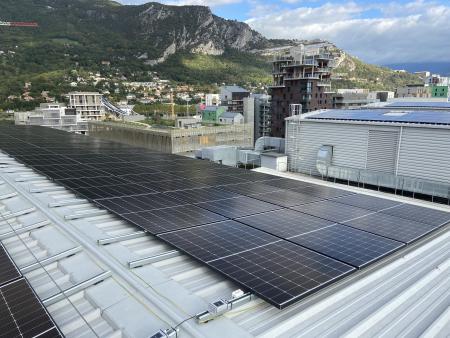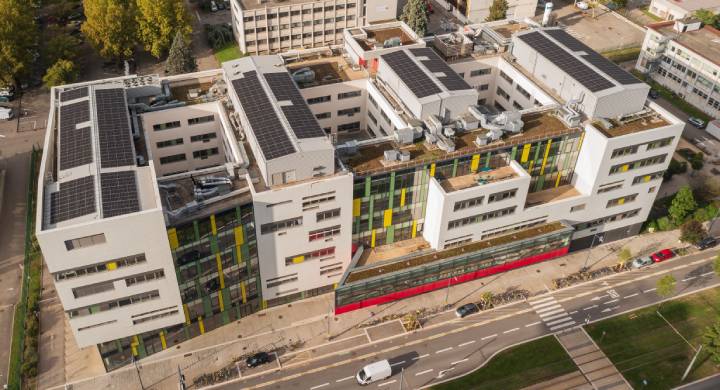The principle of collective self-consumption involves sharing locally produced electricity between producers and consumers connected to the public distribution network within the same geographical area. In 2017, this practice was authorised for groups connected to the low voltage distribution network, and since March 2021 it has been opened up to buildings connected to the medium voltage network. This is the case, for example, of the buildings of Grenoble INP - UGA, which are gradually experimenting with the concept.
Collective self-consumption consists of directly consuming the electricity produced locally by solar panels for example and sending the surplus back to the public grid via the point of connection to the grid. The equivalent amount of what is sent back to the grid is recorded every half hour and is deducted from the energy bills of buildings within a 2 km radius. In the case of Grenoble INP, an 890m² photovoltaic plant has been installed on the roof of the GreEn-ER building and has been operational since late summer 2022. The surplus produced will be deducted from the bills of the Grenoble INP buildings located within a two-kilometre radius, i.e. the Minatec and Viallet sites.
“Over the year, the plant will produce 10% of the energy required by GreenER, which will be almost entirely self-consumed,” explains Frédéric Wurtz, a teacher at Grenoble INP – Ense3 and CNRS researcher at G2Elab*.
“The surplus produced during weekends and school holidays will be used to supply other buildings.”
 Towards an “energy internet”
Towards an “energy internet”
And this is just the beginning. From 2023, a similar project will be implemented on the SMH campus, with the Pluriel and Phelma A and C buildings.
“The Pluriel building has a photovoltaic production capacity of more than 150 Kilowatt-peak, but the site only uses 10 to 20. You can clearly see the advantage of producing energy on this roof and sending the surplus to other buildings.” For Frédéric Wurtz, collective self-consumption paves the way for the development of a kind of “energy internet”. KWh produced in one place can now be shared and sent to other buildings via the public network.
More generally, a study carried out by Grenoble INP and UGA property services has shown that the solar panels of the Grenoble university campus have the potential to produce more than 20% of the 50 GWh requirement forecast by 2030 by the Grenoble metropolitan area in its energy transition plan. Of the more than 13 GWh potentially produced (which represents 25% of the university's overall electricity consumption), most would be sent to the grid to supply the university's other buildings. The operation would be especially profitable given the spectacular rise in energy prices.
“By doing this, we can control the cost of the KWh. It is only linked to the installation cost of the solar power plant and is not subject to market fluctuations.” The savings will be used to invest in new projects like this one.
An agreement is currently being negotiated with the network operator to calculate the price of KWh returned to the network as accurately as possible and to deduct the corresponding amount from the energy bills of the other buildings. This type of operation is intended to be operated by Enogrid, a start-up run by a graduate of Grenoble INP - Ensimag, UGA, which is developing the technical platforms required for these complex calculations, to help others wishing to embark on the promising adventure of collective self-consumption.
*CNRS, Grenoble INP – UGA, UGA




 Towards an “energy internet”
Towards an “energy internet”